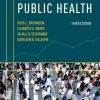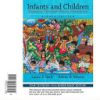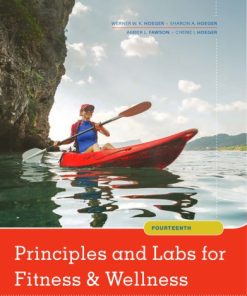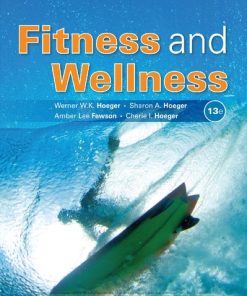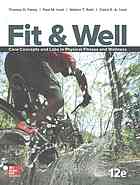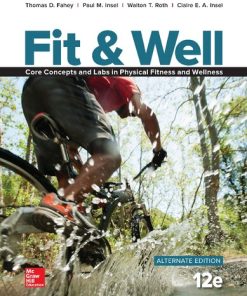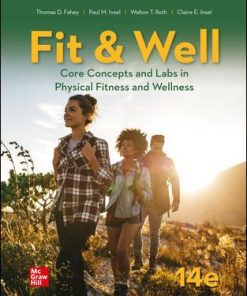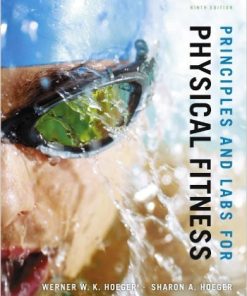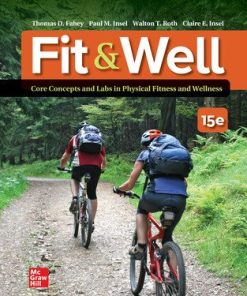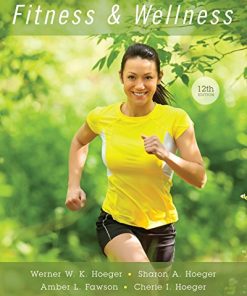Principles and Labs for Fitness and Wellness 15th Edition by Werner Hoeger, Sharon Hoeger, Cherie Hoeger, Amber Fawson 8214350943 9798214350943
$50.00 Original price was: $50.00.$25.00Current price is: $25.00.
Principles and Labs for Fitness and Wellness 15th Edition by Werner W.K. Hoeger, Sharon A. Hoeger, Cherie I. Hoeger, Amber L. Fawson – Ebook PDF Instant Download/DeliveryISBN: 8214350943, 9798214350943
Full download Principles and Labs for Fitness and Wellness 15th Edition after payment.
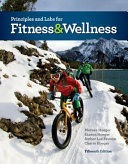
Product details:
ISBN-10 : 8214350943
ISBN-13 : 9798214350943
Author: Werner W.K. Hoeger, Sharon A. Hoeger, Cherie I. Hoeger, Amber L. Fawson
Accept the wellness challenge with PRINCIPLES AND LABS FOR FITNESS AND WELLNESS, 15th Edition! Designed to get you off the couch and into an active lifestyle, this book challenges you to be your best self and inspire others while you’re at it. By adopting key behavior modification techniques and making small changes in your life, obstacles disappear–along with bad habits. This book also gives you the tools to create the right exercise program for your values, make solid nutrition choices, lead an active lifestyle and overcome any barriers to personal change you may face.
Principles and Labs for Fitness and Wellness 15th Table of contents:
1. Physical Fitness and Wellness
Objectives
Real Life Story. Jeremy’s Experience
1.1. The Wellness Challenge for You Today
1.2. Life Expectancy
The Gender Gap in Life Expectancy
The Need to Prevent Disease, Not Only Cure It
1.3. Leading Health Problems in the United States
Diseases of the Cardiovascular System
Cancer
Chronic Lower Respiratory Disease
Accidents
Medical Error in U.S. Hospitals: An Untracked Mortality Risk
1.4. Physical Activity Affects Health and Quality of Life
Exercise Is Medicine
1.5. Additional Benefits of a Comprehensive Fitness Program
Health Benefits
Exercise and Brain Function
1.6. Sitting Disease: A 21st-Century Chronic Disease
1.7. Physical Activity and Exercise Defined
1.8. Types of Physical Fitness
1.9. Fitness Standards: Health versus Physical Fitness
Health Fitness Standards
Physical Fitness Standards
Which Program Is Best?
1.10. Federal Guidelines for Physical Activity
1.11. Monitoring Daily Physical Activity
Activity Trackers
Recommended Steps per Day
1.12. Economic Benefits of Physical Activity
1.13. Wellness
The Seven Dimensions of Wellness
Physical Wellness
Emotional Wellness
Mental Wellness
Social Wellness
Environmental Wellness
Occupational Wellness
Spiritual Wellness
1.14. Meeting the Challenge for Our Day
1.15. Wellness Education: Using This Book
A Personalized Approach
Exercise Safety
1.16. Assessment of Resting Heart Rate and Blood Pressure
Mean Blood Pressure
Assess Your Behavior
Assess Your Knowledge
Lab 1A. Daily Physical Activity Log
Lab 1B. Wellness Lifestyle Questionnaire
Lab 1C. Health History Questionnaire
Lab 1D. Resting Heart Rate and Blood Pressure
2. Behavior Modification
Objectives
Real Life Story. Sharon’s Experience
2.1. Living in a Toxic Health and Fitness Environment
Environmental Influence on Physical Activity
Environmental Influence on Diet and Nutrition
2.2. Keys to Changing Behavior
Personal Values and Behavior
Your Unique Individuality and Nature
2.3. Your Brain and Your Habits
Changing Habits through Mindfulness and Repetition
Changing Habits by Focusing on Long-Term Values
2.4. Planning and Willpower
Growth versus Fixed Mindset
Implementation Intentions
2.5. Self-Efficacy
Sources of Self-Efficacy
2.6. Motivation and Locus of Control
2.7. Barriers to Change
2.8. Behavior Change Theories
Learning Theories
2.9. The Transtheoretical Model of Change
Relapse
2.10. The Process of Change
Consciousness-Raising
Techniques of Change
2.11. Goal Setting and Evaluation
SMART Goals
Goal Evaluation
Assess Your Behavior
Assess Your Knowledge
Lab 2A. Exercising Control Over Your Physical Activity and Nutrition Environment
Lab 2B. Behavior Modification Plan
Lab 2C. Setting SMART Goals
3. Nutrition for Wellness
Objectives
Real Life Story. Gunther’s Experience
3.1. Nutrients
3.2. Carbohydrates
Simple Carbohydrates
Complex Carbohydrates
Fiber
Types of Fiber
Computing Daily Carbohydrate Requirement
3.3. Fats (Lipids)
Simple Fats
Compound Fats
Derived Fats
3.4. Proteins
3.5. Vitamins
3.6. Minerals
3.7. Water
3.8. A Healthy Diet
3.9. Nutrition Standards
Dietary Reference Intakes
Daily Values
3.10. Nutrient Analysis
3.11. Achieving a Balanced Diet
3.12. Choosing Healthy Foods
3.13. Vegetarianism
Nutrient Concerns
3.14. Nuts
3.15. Soy Products
3.16. Probiotics
3.17. Advanced Glycation End Products
3.18. Diets from Other Cultures
Mediterranean Diet
Ethnic Diets
3.19. Nutrient Supplementation
Antioxidants
Multivitamins
Vitamin D
Folate
3.20. Benefits of Foods
3.21. Functional Foods
3.22. Organic Foods
3.23. Genetically Modified Crops
3.24. Energy Substrates for Physical Activity
Energy (ATP) Production
3.25. Nutrition for Athletes
Carbohydrate Loading
Strenuous Exercise and Strength Training
Hyponatremia
3.26. Bone Health and Osteoporosis
3.27. Iron Deficiency
3.28. 2015–2020 Dietary Guidelines for Americans
Key Recommendations
Physical Activity Recommendation
3.29. Proper Nutrition: A Lifetime Prescription for Healthy Living
Assess Your Behavior
Assess Your Knowledge
Lab 3A. Nutrient Analysis
Lab 3B. MyPlate Record Form
4. Body Composition
Objectives
Real Life Story. Camille’s Experience
4.1. What Is Body Composition?
Types of Body Fat
Essential and Storage Fat
4.2. Why Does Body Composition Matter?
High Body Weight Does Not Always Mean High Body Fat
Low Body Weight Does Not Always Mean Low Body Fat
Weight Loss versus Fat Loss
Avoiding Creeping Changes in Body Composition
4.3. Body Shape and Health Risk
Subcutaneous and Visceral Fat
4.4. Techniques to Assess Body Composition
Dual Energy X-ray Absorptiometry
Hydrostatic Weighing
Air Displacement
Skinfold Thickness
Girth Measurements
Bioelectrical Impedance
4.5. Metrics Used to Assess Body Size and Shape
Body Mass Index
Waist Circumference
Waist-to-Height Ratio: “Keep Your Waist Circumference to Less than Half Your Height”
Obtaining an Accurate Waist Measurement
4.6. Determining Recommended Body Weight
Begin with Your Current Body Composition
Calculate Your Recommended Body Weight
4.7. Importance of Regularly Assessing Body Composition
Assess Your Behavior
Assess Your Knowledge
Lab 4A. Body Composition, Disease Risk Assessment, and Recommended Body Weight Determination
5. Weight Management
Objectives
Real Life Story. David’s Experience
5.1. Weight Management in the Modern Environment
The Wellness Way to Lifetime Weight Management
5.2. Overweight versus Obese
Body Weight Affects Wellness
5.3. Tolerable Weight
Body Image and Acceptance
5.4. The Weight-Loss Dilemma
Consequences of Yo-Yo Dieting
Diet Crazes
Low-Carb Diets
Exercise-Related Weight-Loss Myths
Adopting Permanent Change
5.5. Mental and Emotional Aspects of Weight Management
Willpower versus Planning
Mindful Eating versus Distracted Eating
Avoiding Perfectionism
Feelings of Satisfaction versus Deprivation
Eating and the Social Environment
Overcoming Emotional Eating
5.6. Physiology of Weight Loss
Energy-Balancing Equation
Setpoint Theory
Maintaining Metabolism and Lean Body Mass
Rate of Weight Loss in Men versus Women
Protein, Fats, Fiber, and Feeling Satisfied
5.7. Losing Weight the Sound and Sensible Way
Estimating Your Daily Energy Requirement
Adjusting Your Fat Intake
The Importance of Breakfast
Drink Water and Avoid Liquid Calories
Reducing Your Eating Occasions
Foods That Aid in Weight Loss
Monitoring Your Diet with Daily Food Logs
5.8. Nondietary Factors That Affect Weight Management
Sleep and Weight Management
Light Exposure and BMI
Monitoring Body Weight
5.9. Physical Activity and Weight Management
Physical Activity and Energy Balance
Physical Activity Predicts Success at Weight Management
Amount of Physical Activity Needed for Weight Loss
Exercise and Body Composition Changes
Overweight and Fit Debate
5.10. Types of Exercise Recommended
Energy Expenditure Following a Weight-Loss Program
The Roles of Exercise Intensity and Duration in Weight Management
5.11. Healthy Weight Gain
5.12. Behavior Modification and Adherence to a Weight Management Program
The Simple Truth
Assess Your Behavior
Assess Your Knowledge
Lab 5A. Computing Your Dally Caloric Requirement
Lab 5B. Weight-Loss Behavior Modification Plan
Lab 5C. Calorie-Restricted Diet Plans
Lab 5D. Healthy Plan for Weight Maintenance or Gain
Lab 5E. Weight Management: Measuring Progress
6. Cardiorespiratory Endurance
Objectives
Real Life Story. Karen’s Experience
6.1. Basic Cardiorespiratory Physiology: A Quick Survey
6.2. Aerobic and Anaerobic Exercise
6.3. Benefits of Aerobic Exercise
6.4. Assessing Physical Fitness
Responders versus Nonresponders
6.5. Assessing Cardiorespiratory Endurance
Components of VO 2
Tests to Estimate VO 2 max
Interpreting the Results of Your VO 2 max
6.6. Ready to Start an Exercise Program?
6.7. Guidelines for Developing Cardiorespiratory Endurance
Intensity
Moderate versus Vigorous-Intensity Exercise
Monitoring Exercise Heart Rate
Perceived Exertion of Physical Activity
Type (Mode)
Time (Duration)
Frequency
Volume
Progression Rate
6.8. Rating the Fitness Benefits of Aerobic Activities
6.9. Getting Started and Adhering to a Lifetime Exercise Program
A Lifetime Commitment to Fitness
Assess Your Behavior
Assess Your Knowledge
Lab 6A. Cardiorespiratory Endurance Assessment
Lab 6B. Caloric Expenditure and Exercise Heart Rate
Lab 6C. Exercise Readiness Questionnaire
Lab 6D. Cardiorespiratory Exercise Prescription
7. Muscular Fitness
Objectives
Real Life Story. Demetrio’s Experience
7.1. Benefits of Strength Training
Improves Functional Capacity
Improves Overall Health
Increases Muscle Mass and Resting Metabolism
Improves Body Composition
Helps Control Blood Sugar
Enhances Quality of Life as You Age
7.2. Gender Differences
7.3. Assessing Muscular Strength and Endurance
Muscular Strength: Hand Grip Strength Test
Muscular Endurance Test
Muscular Strength and Endurance Test
Basic Muscle Physiology
Types of Muscle Hypertrophy
7.4. Factors That Affect Muscular Fitness
Neural Function
Types of Muscle Fiber
Overload
Specificity of Training
Training Volume
Periodization
7.5. Guidelines for Strength Training
Type (Mode) of Training
Intensity (Resistance)
Time (Sets)
Frequency
Results in Strength Gain
7.6. Dietary Guidelines for Strength and Muscular Development
7.7. Strength-Training Exercises
Exercise Variations
Plyometric Exercise
Core Strength Training
Stability Exercise Balls
Elastic-Band Resistive Exercise
7.8. Exercise Safety Guidelines
7.9. Setting up Your Own Strength-Training Program
Assess Your Behavior
Assess Your Knowledge
Lab 7A. Muscular Strength and Endurance Assessment
Lab 7B. Strength-Training Program
Strength-Training. Exercises without Weights
Strength-Training. Exercises with Weights
Strength-Training. Stability Ball Exercises
8. Muscular Flexibility
Objectives
Real Life Story. Gina’s Experience
8.1. Benefits of Good Flexibility
Maintains Healthy Muscles and Joints
Improves Mental Health
Relieves Muscle Cramps
Improves Posture and Prevents Low Back Pain
Relieves Chronic Pain
8.2. What Factors Affect Flexibility?
Joint Structure
Adipose Tissue
Muscular Elasticity and Genetics
Body Temperature
Age
Gender
Level of Physical Activity
8.3. Assessing Flexibility
Interpreting Flexibility Test Results
8.4. Guidelines for Developing Muscular Flexibility
Types of Stretching Exercises
Physiological Response to Stretching
Frequency
Intensity
Time/Repetitions
Volume
Pattern/When to Stretch?
8.5. Flexibility Exercises
Exercises That May Cause Injury
8.6. Preventing and Rehabilitating Low Back Pain
Causes of Low Back Pain
Improving Body Posture
When to Call a Physician
Treatment Options
Personal Flexibility and Low Back Conditioning Program
Assess Your Behavior
Assess Your Knowledge
Lab 8A. Muscular Flexibility Assessment
Lab 8B. Posture Evaluation
Lab 8C. Flexibility Development and Low Back Conditioning Programs
Flexibility. Flexibility Exercises
Exercises. Exercises for the Prevention and Rehabilitation of Low Back Pain
9. Personal Fitness Programming
Objectives
Real Life Story. Jeremy’s Experience
9.1. Choosing an Exercise Program with Your Values in Mind
Being Flexible with Your Exercise Routine
9.2. Keys to Planning Exercise for Health and Fitness
Basic Exercise Training Principles
Interval Training
High-Intensity Interval Training
Ultra-Short Workouts
Cross-Training
Overtraining
Periodization
9.3. Skill-Related Fitness
The Six Components of Skill-Related Fitness
Team Sports
Performance Tests for Skill-Related Fitness
9.4. Training for Sports Participation
Preparing for Sports Participation
Base Fitness Conditioning
Sport-Specific Conditioning
Training for Distance
Sport-Specific Flexibility Training
9.5. General Exercise Considerations
Time of Day for Exercise
Exercise in Heat and Humidity
Exercise in Cold Weather
Exercising with the Cold or Flu
9.6. Nutrition and Hydration during Exercise
Fluid Replacement during Exercise
Meal Timing during Exercise
9.7. Exercise-Related Injuries
Muscle Soreness and Stiffness
Exercise Intolerance
Side Stitch
Shin Splints
Muscle Cramps
Acute Sports Injuries
9.8. Tailoring Exercise to Health Circumstances
Asthma and Exercise
Arthritis and Exercise
Diabetes and Exercise
Smoking and Exercise
9.9. Women’s Health and Exercise
Menstruation and Exercise
The Female Athlete Triad
Exercise and Dysmenorrhea
Exercise during Pregnancy
9.10. Exercise and Aging
Benefits of Lifelong Exercise
Exercise Training for Seniors
Body Composition in Seniors
Exercise and Mental Health in Seniors
Exercise Recommendations for Seniors
9.11. You Can Get It Done
Assess Your Behavior
Assess Your Knowledge
Lab 9A. Personal Reflection on Exercise and Exercise Enjoyment
Lab 9B. Assessment of Skill Fitness
Lab 9c. Personal Fitness Plan
10. Stress Assessment and Management Techniques
Objectives
Real Life Story. Jose’s Experience
10.1. The Mind–Body Connection
Emotions Can Trigger Physical Responses
10.2. What Is Stress?
Eustress and Distress
10.3. How the Body Responds and Adapts to Stress
Alarm Reaction
Resistance
Exhaustion and Recovery
Examples of General Adaptation Syndrome
10.4. Sources of Stress
10.5. How Perception and Attitude Affect Health
Self-Esteem
Fighting Spirit
10.6. How Behavior Patterns Affect Health
Type A
Type B
Type C
Certain Type A Behavior Increases Risk for Disease
Type A Personality and Hostility Assessment
10.7. Vulnerability to Stress
10.8. Sleep Management
How Much Sleep Do I Need?
What Happens If I Don’t Get Enough Sleep?
College Students Are among the Most Sleep-Deprived
Does It Help to “Catch Up” on Sleep on Weekends?
10.9. Time Management
Five Steps to Time Management
10.10. Managing Technostress
10.11. Coping with Stress
Identify and Change Stressors within Your Control
Accept and Cope with Stressors beyond Your Control
Control Stress with Exercise
Relaxation Techniques
10.12. Which Technique Is Best?
Assess Your Behavior
Assess Your Knowledge
Lab 10A. Stress Events Scale
Lab 10B. Type A Personality and Hostility Assessment
Lab 10C. Stress Vulnerability Questionnaire
Lab 10D. Goals and Time Management Skills
Lab 10E. Stress Management
11. Preventing Cardiovascular Disease
Objectives
Real Life Story. Rita’s Experience
11.1. Cardiovascular Disease
11.2. Most Prevalent Forms of Cardiovascular Disease
11.3. Stroke
11.4. Coronary Heart Disease (CHD)
Coronary Heart Disease Risk Profile
11.5. Leading Risk Factors for Coronary Heart Disease
Physical Inactivity
Abnormal Electrocardiograms
Abnormal Cholesterol Profile
Elevated Triglycerides
Elevated Homocysteine
Inflammation
Diabetes
Hypertension (High Blood Pressure)
Excessive Body Fat
Tobacco Use
Tension and Stress
Personal and Family History
Age
11.6. Cardiovascular Risk Reduction
Assess Your Behavior
Assess Your Knowledge
Lab 11A. Self-Assessment Coronary Heart Disease Risk Factor Analysis
12. Cancer Prevention
Objectives
Real Life Story. Yolanda’s Experience
12.1. How Cancer Starts
DNA Mutations
Tumor Formation
Metastasis
12.2. Genetic versus Environmental Risk
Epigenetics
12.3. Incidence of Cancer
12.4. Guidelines for Preventing Cancer
Top Twelve Recommendations for a Cancer Prevention Lifestyle
How Can I Know Which Substances Cause Cancer?
12.5. Adopt Healthy Lifestyle Habits
12.6. Consume a Well-Balanced Diet with Ample Amounts of Fruits and Vegetables
Vegetables and Legumes
Phytonutrients
Antioxidants
Tea
Vitamin D
Fiber and Calcium
Spices
Monounsaturated and Omega-3 Fats
Soy
Processed Meat and Protein
Starches Cooked at High Heat
Sugar
Alcohol Consumption
Nutrient Supplements
12.7. Maintain Recommended Body Weight
12.8. Abstain from Tobacco
12.9. Avoid Excessive Sun Exposure
How Risky Is the Occasional Sunburn?
How Risky Is Indoor Tanning?
12.10. Monitor Estrogen, Radiation Exposure, and Potential Occupational Hazards
12.11. Be Physically Active
12.12. Other Factors
12.13. Screening and Early Detection
12.14. Nine Warning Signs of Cancer
12.15. Cancer: Assessing Your Risks
Risk Factors for Common Sites of Cancer
12.16. What Can You Do?
Assess Your Behavior
Assess Your Knowledge
Lab 12A. Cancer Prevention Guidelines
Lab 12B. Early Signs of Illness
Lab 12C. Cancer Risk Profile
13. Addictive Behavior
Objectives
Real Life Story. Jose’s Experience
13.1. Addiction
13.2. How Addiction Develops
13.3. Drug Misuse and Abuse
Caffeine
Nonmedical Use of Prescription Drugs
Inhalant Abuse
Marijuana
Cocaine
Methamphetamine
MDMA (Ecstasy)
Heroin
New Psychoactive Substances (Synthetic Drugs)
Synthetic Cannabinoids (Fake Pot or Spice)
13.4. Alcohol
Effects on the Body
Current Trends
Addictive and Social Consequences of Alcohol Abuse
Alcohol on Campus
How to Cut Down on Drinking
13.5. Treatment of Addictions
13.6. Tobacco
Types of Tobacco Products
Effects on the Cardiovascular System
Smoking and Cancer
Effects of Secondhand Smoke
Health Care Costs of Smoking
Morbidity and Mortality
Trends against Tobacco
13.7. Why Smoking Is Addicting
Why Do You Smoke? Test
13.8. How to Quit
Do You Want to Quit? Test
Quitting Cold Turkey
Cutting Down Gradually
Nicotine-Substitution Products
13.9. Life after Cigarettes
Enjoy Immediate Health Benefits
Think of Yourself as a Non-Smoker
Assess Your Behavior
Assess Your Knowledge
Lab 13A. Addictive Behavior Questionnaires
Lab 13B. Smoking Cessation Questionnaires
14. Preventing Sexually Transmitted Infections
Objectives
Real Life Story. Darlene’s Experience
14.1. Types and Causes of Sexually Transmitted Infections
14.2. Four Most Common Bacterial/Parasitical STIs
Chlamydia
Gonorrhea
Syphilis
Trichomoniasis
14.3. Four Most Common Viral STIs
Human Papillomavirus (HPV) and Genital Warts
Genital Herpes
Hepatitis
HIV and AIDS
14.4. Preventing Sexually Transmitted Infections
Wise Dating
Monogamous Sexual Relationship
Assess Your Behavior
Assess Your Knowledge
Lab 14A. Self-Quiz on HIV and AIDS
15. Lifetime Fitness and Wellness
Objectives
Real Life Story. James’s Experience
15.1. Chronological versus Physiological Age
15.2. Life Expectancy
15.3. Conventional Western Medicine
Finding a Physician
Searching for a Hospital
15.4. Complementary and Alternative Medicine
Types of CAM Practices
Costs for CAM
CAM Shortcomings
Finding a CAM Practitioner
15.5. Integrative Medicine
15.6. Quackery and Fraud
Deception in Advertising
Deception in the Media
Tips to Avoid Unreliable Information Online
How to Research and Report Consumer Fraud
15.7. Looking at Your Fitness Future
Health and Fitness Club Memberships
Personal Trainers
Choosing a Certified Trainer
Purchasing Exercise Equipment
15.8. Self-Evaluation and Behavioral Goals for the Future
Self-Evaluation
Behavioral Goals for the Future
15.9. The Fitness and Wellness Experience: Patty’s Success
15.10. A Lifetime Commitment to Fitness and Wellness
People also search for Principles and Labs for Fitness and Wellness 15th:
borrow principles and labs for fitness and wellness
cengage principles and labs for fitness and wellness
principles and labs for fitness and wellness pdf
principles and labs for fitness and wellness 16th edition ebook
principles and labs for fitness and wellness 16th edition pdf
Tags: Principles, Labs, Fitness, Wellness, Werner Hoeger, Sharon Hoeger, Cherie Hoeger, Amber Fawson
You may also like…
Medicine
Principles and Labs for Fitness and Wellness 1st edition by Werner Hoeger 133709997X 9798214351278
Relationships & Lifestyle - Diet & Nutrition
Relationships & Lifestyle - Diet & Nutrition
Fit & Well: Core Concepts and Labs in Physical Fitness and Wellness 12th Edition
Uncategorized
(eBook PDF) Fit & Well: Core Concepts and Labs in Physical Fitness and Wellness 14th Edition
Hobbies & Games - Training & Coaching
Uncategorized
Uncategorized
Fit & Well: Core Concepts and Labs in Physical Fitness and Wellness 13th Edition – Ebook PDF Version


